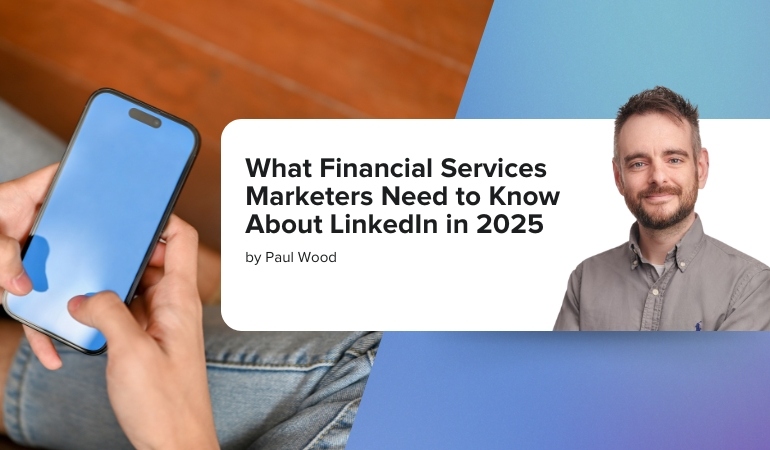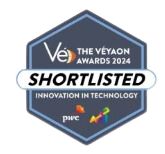I spent this morning underneath the shadow of St Paul’s Cathedral at the Financial Services Forum’s event on LinkedIn in 2025. The panel discussion was a refreshingly deep look into the B2B social platform.
So, what does LinkedIn look like in 2025, and what should we, as financial services marketers, take note of?
Here’s what stood out to me.
LinkedIn for financial services in 2025
Native-first
It’s perhaps obvious but worth reminding ourselves: LinkedIn wants to keep visitors on its platform. LinkedIn generates revenue when users view ads. The more users it keeps on its platform, the more ads they see, and the more revenue it generates.
For this simple reason, the incentive system behind LinkedIn is geared towards keeping people on its site.
That’s not to say that LinkedIn can’t generate traffic for your website; it can, but more often than not, it will favour content that keeps visitors in its garden.
Panelists Tracy Knatt, Global Head of Social Media & Corporate Web at AXA Investment Management, and Tara Cimino, Head of Paid Media at The Dubs, an agency, discussed the changing format of external links on LinkedIn.
“Organic external links are now a small thumbnail, where once they used to be a large image”.
It’s a visual representation of the hierarchy that LinkedIn applies to the content on its site.
LinkedIn and Instagram
“We use Instagram, we have strong engagement with the posts we share,” was the response from Tracy Knatt when asked about utilising additional social media platforms at AXA IM.
“It is very different to LinkedIn, much more oriented to the culture and values at the company,” she explained.
The message was clear: where LinkedIn excels at thought leadership and expertise, Instagram is often the perfect place to demonstrate company values.
Scheduling isn’t just about scheduling
The panel discussion touched on scheduling content, prompted by an audience question. Whilst the merits of scheduling as an efficiency finder were discussed, Tracy Knatt of AXA IM gave an alternative view: centralised scheduling is a great compliance tool.
“A benefit of scheduling tools is that we don’t need to provide direct access to lots of other people.”
In using a centralised publishing tool, in this case, Khorus, AXA IM negates the need to share individual account access to lots of people.
“It [also] creates a workflow that enables content to be reviewed before it goes live.”
When to publish
On the subject of scheduling, third panel member, Catherine Storey, CEO of Freshbat, an agency, said, “the best time to post is the time that’s best for you.”
The message here was that it’s more important to publish your content than it is to fret over when the best time to post is.
“LinkedIn posts have a longer shelf life than other platforms,” Storey explained, providing examples of when she has seen content on the platform that is perhaps weeks old but still being served by the system.
Asset format matters more than just because of mobile
Asset format was a recurring point of discussion, with panel members agreeing that mobile-first graphics are the direction of travel.
A stat verified during the session confirmed that 80% of engagement on LinkedIn comes from users on mobile devices (source: LinkedIn).
For this reason, using square or portrait format assets is the smart move, but not just because it works on mobile.
“If you use landscape assets, it means people will see the next post below yours and get distracted [on a desktop]”, explained Tara Cimino.
Do you need hashtags?
“A quality post with no hashtags will outperform a poor quality post with hashtags,” explained Catherine Storey when asked about the importance of hashtags.
Cimino followed up by also speaking about tagging fellow LinkedIn users when you post; “a tag of a person becomes a link in your post,” that link might then compete with your primary call to action.
When you publish a post to LinkedIn, if you include a call to action, be mindful of the other links (hashtags, user tags) calling for your audience’s attention.
My take
Throughout the session, I was reminded of a communication model I’ve always turned to. I believe it came from the advertising man, Dave Trott, but is likely repurposed in lots of places.
It goes like this, in order to run a successful communications campaign you need three steps:
- Step 1: Gain the audience’s attention
- Step 2: Communicate what you would like the audience to do
- Step 3: Convince the audience to go along with you
The example Trott uses is:
- Step 1: “Hey, Mrs Trott…”
- Step 2: “Would you mind making me a cup of tea?”
- Step 3: “I can take the bins out whilst you do in return”
Most marketing communications spend a lot of time on steps 2 and 3; working out how to ask and convince people to make them a cup of tea.
The trouble is that without as much effort on step 1, we often craft incredible messages that nobody sees.
It strikes me that LinkedIn is an opportunity to get attention. The panel discussed the ‘sea of sameness’ that exists across social media, so in order to gain attention, we need to be doing something interesting, but LinkedIn is a place where that can happen.
‘Entertain, inform, or inspire’ was Catherine Storey’s advice when it comes to standing out on LinkedIn. It’s advice that should stick for any platform.
If you understand your audience, chances are it exists to some extent on LinkedIn. If you can crack the art of creating content that actually entertains, informs, or inspires them, you might just end up with that cup of tea you are asking for.





